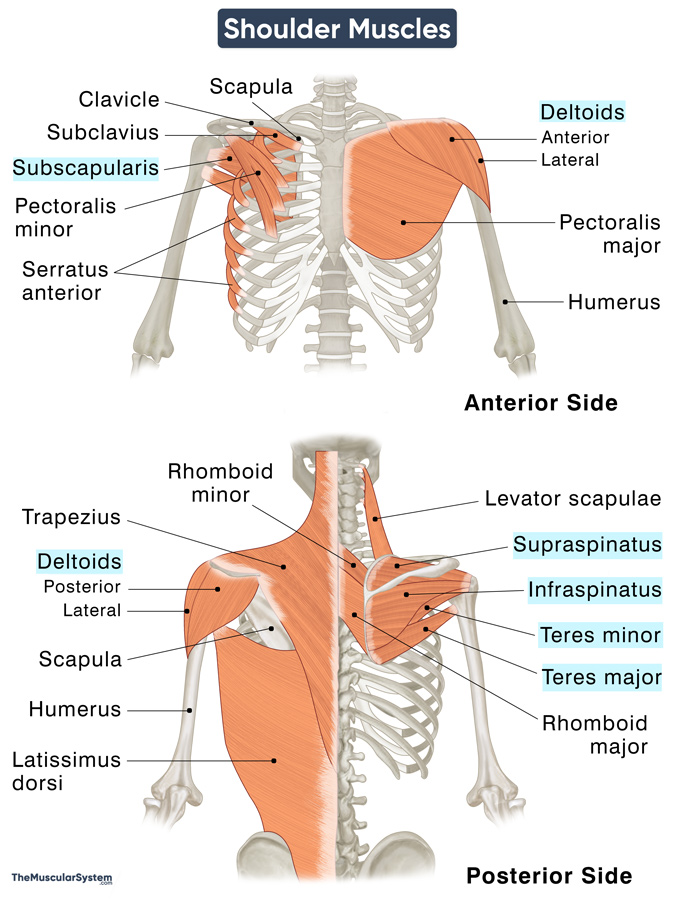Shoulder Muscles
The shoulder is one of the biggest joints in the human body, involved in almost all upper-body movements. Also called the glenohumeral joint, it is a ball-and-socket joint capable of the widest range of movements in the body, controlled by the six shoulder muscles. These muscles keep the shoulder joint in place, give the shoulder its characteristic shape, and strengthen it.
There are certain muscles in your thoracic cage and back that support and assist the shoulder muscles in their functions.
Names of the Muscles of the Shoulder With Location & Anatomy
The muscles that support and stabilize the shoulder are classified into two groups based on their location: anterior axioappendicular muscles and posterior axioappendicular muscles. These are called axioappendicular muscles because they connect the axial skeleton to the appendicular skeleton by attaching the arm to the torso.
The posterior axioappendicular muscles can further be divided into extrinsic and intrinsic groups. The extrinsic muscles originate from the torso and attach to one of the three shoulder bones, scapula, clavicle, or humerus. On the other hand, the intrinsic muscles originate from either the scapula or clavicle, attaching to the humerus.
The 6 intrinsic posterior axioappendicular muscles are categorized as shoulder muscles:
- Deltoid: The large triangular muscle forming the top of the shoulder and giving it its rounded shape. It is the biggest muscle in the shoulder, having three parts — anterior, lateral, and posterior deltoid — all originating from different parts of the scapula and inserting into the humerus. The deltoids are responsible for all the major arm movements, including abduction, adduction, extension, and flexion of the humerus.
- Supraspinatus: It is a small muscle connecting the top of the scapula to the head of the humerus as the shoulder joint. This muscle holds the shoulder joint in place, helps initiate the movement of raising your arms to the sides, and helps the deltoid with its actions.
- Infraspinatus: It is a relatively large triangular muscle that covers the posterior surface of the scapula, connecting it to the humerus. It also assists in keeping the shoulder joint in place, along with helping with the external or outward rotation of the arm.
- Teres minor: It is a small muscle stretching from the outer border of the scapula to the humerus. The teres minor also provides stability to the shoulder and acts to rotate the arm outward.
- Teres major: It is a thick small muscle stretching from the scapula’s lower surface to the front of the humerus. It runs across the region just below the armpit to reach the humerus. This muscle has several actions in extending and adducting the arm, as well as rotating it inwards.
- Subscapularis: This strong, large muscle covers the entire front surface of the scapula, extending to the head of the humerus. Its primary function involves rotating the arm medially.
The supraspinatus, infraspinatus, teres minor, and subscapularis together form the rotator cuff. It is a group of these 4 muscles that surround the shoulder joint to stabilize it by holding the head of the humerus in its place within the glenoid cavity during any kind of shoulder and arm movement.
Surrounding Muscles that Work With the Shoulder Muscles
Anterior (front) axioappendicular muscles
Posterior (back) axioappendicular muscles (extrinsic)
Functions
The shoulder muscles are skeletal muscles attached to the skeleton by individual tendons. Since these are voluntary muscles, you can control their movement, so you can raise your arm or cross them in front of your chest when you want. They never move by themselves.
Here are the primary functions of the shoulder muscles:
- Stabilizing the shoulder by holding the ball-and-socket glenohumeral joint in place
- Moving the arms in all directions by helping the humerus move while its head stays in place within the glenoid cavity.
- Lending shape and structure to the shoulder
The ranges of motion they participate in at the shoulder are flexion (bending the arm), extension (spreading the arm), abduction (raising the arm to the side), adduction (bringing the arm back towards to body trunk), medial (inward) rotation, and lateral (outward) rotation.
FAQs
Q.1. What muscles internally rotate the shoulder?
Ans. The muscles that take care of the internal or inward rotation of the shoulder are the teres major, subscapularis, and anterior deltoid, along with the pectoralis major and latissimus dorsi.
Q.2. What muscles externally rotate the shoulder?
Ans. The infraspinatus and teres minor, with attachments below the spine of the scapula, are the main muscles that rotate the shoulder externally.
References
- Shoulder Muscles: ClevelandCinic.org
- Anatomy of the Shoulder Muscles Explained: HealthLine.com
- Anatomy, Shoulder and Upper Limb, Shoulder Muscles: NCBI.NIM.NIH.gov
- Shoulder Muscles: www.KenHub.com
- Shoulder Muscles: GetBodySmart






